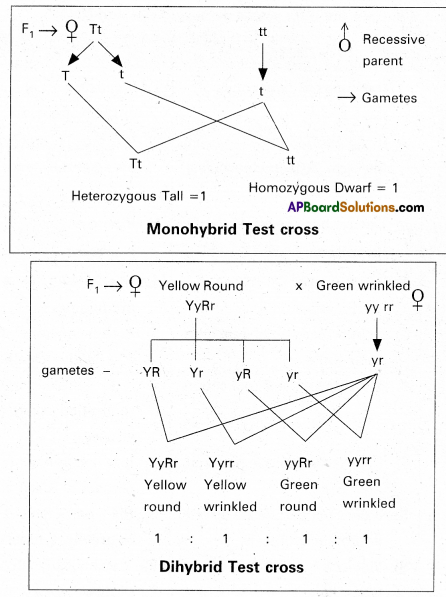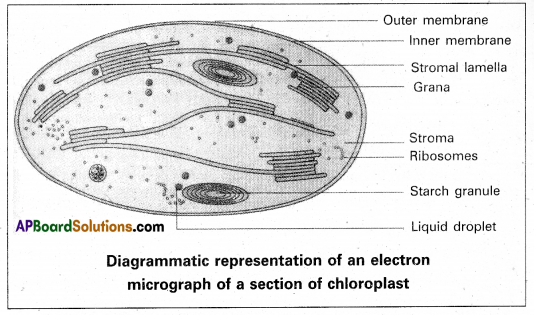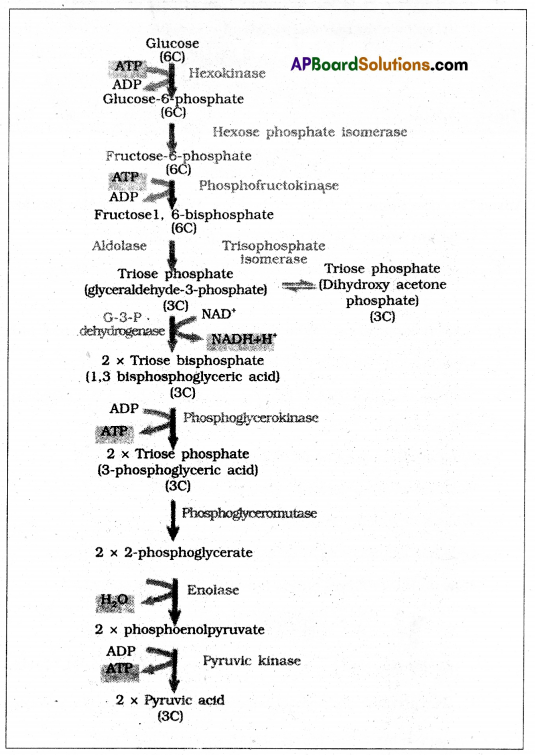Thoroughly analyzing AP Inter 2nd Year Botany Model Papers Set 2 helps students identify their strengths and weaknesses.
AP Inter 2nd Year Botany Model Paper Set 2 with Solutions
Time: 3 Hours
Max. Marks: 60
Section-A
10 × 2 = 20 Marks
Answer all questions
Question 1.
Name any two industrially important enzymes.
Answer:
Lipases, Streptokinase.
Question 2.
Name two semi-dwarf varieties of rice developed in India.
Answer:
Jaya and Ratna.
Question 3.
PCR is a useful tool for early diagnosis of an infectious disease. Elaborate.
Answer:
Very low concentration of a bacteria or virus (at a time when the symptoms of the disease are not get visible) can be defected amplification of their nucleic acid through PCR.
Question 4.
What is GEAC and what are its objectives?
Answer:
GEAC stands for Genetic Engineering Approval Committee. It makes decisions regarding the validity of GM research and the safety of introducing GM organisms for public services.
![]()
Question 5.
What are the components of a transcription unit?
Answer:
- A Promotor
- The structural gene
- A terminator
Question 6.
What is the function of histones in DNA packaging?
Answer:
Histones are highly alkaline proteins that package and order the DNA into structural units called Nucleosomes. They are the chief protein components of proteins acting as spools around which DNA winds and plays a role in gene regulation.
Question 7.
Who proposed the chromosome theory of inheritance?
Answer:
Walter Sulton and Theodole Boyen.
Question 8.
What is a plasmid? What is its significance?
Answer:
“Plasmid is a small self-replicating circular, double standard DNA molecule present in a Bacteria in Addition to main genetic material. They are used as agent [vectors] modern genetic Engineering techniques.
Question 9.
Define plasticity. Give an example.
Answer:
Ability of plants to follow different pathways in response to the environment or phases of life to form different kinds of structures is called plasticity. Ex: Heterophily.
Question 10.
How does guttation differ from transpiration?
Answer:
| Guttation | Transpiration |
| 1) The loss of water from the from the leaves of plants in the liquid form. | 1) The loss of water in the form of water vapour from leaves. |
| 2) It is an uncontrolled process. | 2) It is a controlled process. |
Section-B
6 x 4 = 24 Marks
Answer any six questions.
Question 11.
What are some bio-safety issues concerned with genetically modified crops?
Answer:
- There is fear of transferring allergins or toxins to humans and animals as side effects.
- There is a risk of changing the fundamental nature of vegetables.
- They may pose a harmful effect on biodiversity and have an adverse impact on environment.
- There is a risk of gene pollution due to transfer of the new genes into related wild species through natural outcrossing.
- This may result in the development of super weeds which may be fast growing than the crops and may be resistant to weedicides.
- They may bring about changes in natural evolutionary patterns.
![]()
Question 12.
What are the differences between DNA and RNA?
Answer:
| DNA | RNA |
| 1) It consists of two stands of nucleotides. | 1) It consists on only stand of nucleotides. |
| 2) It is present in mole in nucleus and very little in chloroplast and mitochondria. | 2) It is present more incyto plasm and little in nucleus. |
| 3) Deoxyribose sugar (C5H10O4) is present. | 3) Ribose sugar (C5H10O5) is present. |
| 4) Thymine and cytosine are pyrimidines. | 4) Cracil and cytosine are pyrimidines. |
| 5) DNA is made up of 4 millions nucleotides. | 5) RNA is made up of 75 – 2000 nucleotides. |
| 6) It undergoes self-replication. | 6. It does not undergo self-replication except in RNA viruses |
| 7) DNA is the genetic material. | 7) It is non-genetic material (except in RNA) viruses |
| 8) It does not participate directly in protein synthesis. | 8) RNA participate directly in protein synthesis. |
| 9) Metabolically DNA is of one type | 9) Metabolically RNA is of three types. |
| The base puring is A = T and G = C. | 10) The base puring is A = U and G = C. |
Question 13.
Define and design a test cross.
Answer:
Crossing between F1 individuals with the recessive parent is called test cross. It is used to test whether an individual is homozygous or heterozygous. A mono-hybrid test cross gives a phenotype ratio of 1:1 and a dihybrid test cross gives a ratio of 1:1:1:1.

Question 14.
Explain the structure of T – even bacteriophages.
Answer:
- The viruses which attack bacteria are called Bacteria- phages.
- They were discovered by Twort (1915)
- Felix d Herelle (1917) coined the term Bacteriophage.
- Bacteriophages are tadpoles, shaped with a large head and a tail.
- The head is hexagonal and is capped by hexagonal pyramid measures about 265 x 95nm
- The head is formed with several capsomers, each of which is a single protein.
- The head protein forms a semipermeable membrane enclosing the folded double standard DNA which is 1000 times longer than the phage.
- The tail is composed of several parts present around central core.
- The tail core is 95nm long and 8nm in diameter. It is surrounded by tail sheath composed of 144 subunits which are arranged in 24 rings of 6 each.
- The head and tail are joined by coller whose function is not known.
- At the tip of the tail, hexagonal tail plate is present with six tail pins and tail fibres.
- The tail fibres help in attachment of the phage on the host cell.
![]()
Question 15.
Write a note on agricultural horticultural applications of auxins.
Answer:
- lBS. NAA and ¡AA help to initiate rooting in stem cuttings, widely used for plant propagation in horticulture.
- Auxins like 2,4-D, 2,4,5-T acts as herbicides and kills broad-leaved dicot weeds to prepare weed-free lawns.
- Auxins stimulates fruit growth. Ex: Tomatos.
- Auxins induces flowering in pineapple.
- Prevents pre-harvest fruit drop.
Question 16.
Explain the structure of chloroplast? Draw a neat labelled diagram.
Answer:
Chloroplasts are the oval-shaped cell organdies mainly concerned with the photosynthesis. Inner to inner membrane, there is a membranous system consisting of grama the stroma lamellae and the fluid stoma. The grama is responsible for trapping the light energy and also for the synthesis of ATP and NADPH called light reaction. In stroma, enzymatic reactions incorporate CO2 into the plant, leading to the synthesis of sugar. The process is not directly light-driven but are dependent on the product of light reactions and are called dark reactions.

Question 17.
Nitrogen is fixed into the soil not only by biological processes. Elaborate.
Answer:
Nitrogen is fixed into the solid not only by biological processes but also by a biological process or physical method. It occurs in atmosphere. Due to thunders and lightening, dinitrogen in converted into nitric oxide. Which is further oxidised to nitrogen dioxide. These oxides dissolves in rainwater and reactes soil as nitrous and nitric acids. These acids react with alkali radicles of soil and for nitrates. The soluble nitrates are directly absorbed by plants.
N2+O2 → 2NO
2NO +O2 → 2NO2
2NO2 + H2O → HNO2 + HNO3
HNO3 + Ca or K salts → Ca or k nitrates.
A biological nitrogen fixation is also carried out on industrial scale by Haber bosch process at 450°C with 1000 bars pressure.
Question 18.
Define and explain water potential.
Answer:
The measure of the relative tendency of water to move from one area to Another is called water potential. It is denoted by the Greek symbol psi or ψ and is expressed in Pascals (pa). It has two components namely solute potential and pressure potential.
a) Solute potential: If some solute is added to pure water, the solution has fewer the water molecules and the concentration of water decreases reducing its water potential. The magnitude of this lowering due to disolution of a solute is called solute potential. It is denoted as p. It is always negative.
b) Pressure potential : When water enters a plant cell due to diffusion, causing a pressure to build up against the cell wall. This makes the cell turgid. The magnitude of increases in water potential in such turgid cell is called pressure potential. It is usually positive and denoted as ψp
ψ = ψs + ψp
Section-C
2 x 8 = 16 Marks
Answer any two of the following.
Question 19.
You are a Botanist working in the area of plant breeding. Describe the various steps that you will undertake to release a new variety.
Answer:
The main steps in breeding a new genetic variety of a crop are:
1. Collection of variability: Genetic variability is the root of any breeding programme. Collection and preservation of all the different wild varieties, species and relatives of cultivated species is a prerequisite for effective exploitation of natural genes available in the populations. The entire collection having all the diverse alleles for all gens in a given crop is called Germplasm collection.
2. Evaluation and selection of parents: The germplasm is evaluated so as to identify plants with desirable characters. The selected plants are multiplied and are used. Purelines are created wherever desirable.
3. Cross Hybridisation among the selected parents: After emasculation (Removal of Anthers from bisexual flower of a female parent) the female flowers are enclosed in a polythene bag to prevent undesired cross-pollination. Pollen grains are collected from the male parent with the help of a brush and are transferred to the surface of the stigma and thus cross pollination is affected artificially.
4. Selection and Testing of superior recombinants: It involves selecting among the progeny of hybrids those plants that have the desired character combination. The selection process requires careful scientific evaluation of the progeny. Due to this. plants that are superior to both the parents are obtained. These are self-pollinated for serveral generations till they reach a homozygosity.
5. Testing, release and commercialisation of new characters :
The newly selected lines are evaluated for their yield and other traits of quality, disease resistance etc. It is done by growing these in research fields and recording their performance under ideal fertilizer application, irrigation and other crop management practices. It is followed by testing the materials in farmers’ fields for at least 3 growing seasons at several places in the country. in all agroclimatic zones. Finally, they are distributed to farmers as a new variety.
![]()
Question 20.
Give a brief account of the tools of DNA technology.
Answer:
Key tools are:
1) Restriction enzymes: Two enzymes responsible for restricting the growth of Bacteriophage in Escherichia coil were isolated in the year 1963. One of these added methyl group to DNA and the other cut DNA. The latter was called restriction endonuclease. The first restriction endonuclease- Hind II which cut DNA molecules at a particular point by recognising a specific sequence of six base pairs, called recognition sequence for Hind II. Today more than 900 restriction enzymes were isolated from over 200 strains of Bacteria, each of which recognises a different recognition sequence.
E. CORI is a restriction enzyme in which, the first letter comes from the genus (Escherichia) and the second two letters from the species of the prokaryotic cell (coil) the latter R’ is derived from the name of strain. Roman numbers indicate the order in which the enzymes were isolated from the strain of Bacteria. Restriction enzymes belong to a larger class of enzymes called nucleases. They are of two types:
- Exonucleases which remove nucleotides from the ends of the DNA.
- Endonucleases which makes cuts at specific location within the DNA.
Most restriction enzymes cut the two stands of DNA double helix at different locations such a cleavage is known as staggered cut. E.CORI recognises 5 GAATT3’ sites on the DNA and cut it between G & A results in the formation of sticky ends or cohesive end pieces. This stickyness of the ends facilities the action of enzyme DNA ligase.
Cloning vectors: The DNA used as a carrier for transferring a fragment of foreign DNA into a suitable host is called vector. Vectors used for multiplying the foreign DNA sequences are called cloning vectors.
Commonly used cloning vectors are plasmids, bacteriophages, cosmids, plasmids are extrachromosomal circular DNA molecules present in almost all bacterial species. They are inheritable and carry few genes are easy to isolate and reintroduce into the bacterium (host).
Features required to facilitate cloning into a vector:
a) Origin of replication : (on) This is a sequence from where replication starts and any piece of DNA when linked to this sequence can be made to replicate within host cells. It is also responsible for controlling the copy number of the linked DNA.
b) Selectable marker: In addition to on’ the vector requires a selectable maker, which help in identifying and eliminating non. transformants and selectively permitting the growth of the any transformants normally, the genes encoding resistance to Antibiotics such as Ampicillin, Chloramphenicol, tetracycline or Kanamycin etc. are useful selectable makers for E.coli.
c) Cloning sites: In order to link the alien DNA, the vector needs to have very few, preferably single recognition sites for the restriction enzymes.
d) Molecular weight: The cloning vector should have low molecular weight.
e) Vectors for cloning genes in plants and animals: The tumour-inducing (Ti) plasmid of Agrobacterium tumefacient has now been modified into a cloning vector such that it is no more pathogenic to plants. Similarly, retroviruses have also been disarmed and are now used to deliver desirable genes into animal cells.
![]()
Question 21.
Give an account of Glycolysis. Where does it occur? What are the end products ‘Trace the fate of these products in both aerobic and anaerobic respiration.
Answer:
Glucose is broken down into 2 molecules of pyruvic acid is called Glycolysis. It was given by Gustav Embden, Otto Mayerhof and J.Parnas so called EMP Pathway. It occurs in the cytoplasm of the cell and takes place in all living organisms. In this, 4 ATP are formed of which two are utilized and 2 NADPH+H are formed. At the end of glycolysis. 2 PA. 2 ATP and 2 NADPH+H+ are formed as end products. The ATP and NADPH+H+ are utilised for fixation of CO2.
Glyclosis occurs in cytoplasm, pyruvic acid, 2ATP, 2 NADPH + H are the end products. In aerobic respiration, pyruvic acid, 2 NADPH+H+ are completely oxidised through TCA cycle, ETS pathway and produce 36 ATP molecules. In anaerobic respiration, pyruvic acid is partially, oxidised results in the formation of ethyl alcohol and CO2.
